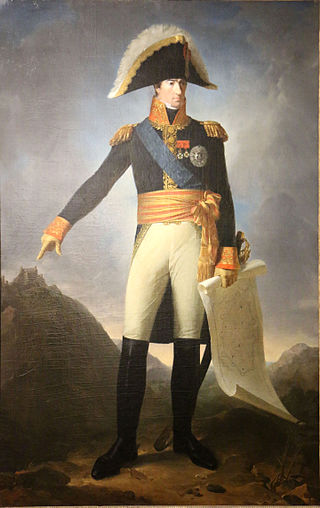
Honoré Théodore Maxime Gazan de la Peyrière was a French general who fought in the French Revolutionary Wars and the Napoleonic Wars.

The French Revolutionary Army was the French land force that fought the French Revolutionary Wars from 1792 to 1802. In the beginning, the French armies were characterised by their revolutionary fervour, their poor equipment and their great numbers. However, the French Revolutionary Army had become arguably the most powerful army in the world by the mid-1790s, as the French armies had become well-experienced and organized, enabling them to comfortably outfight their enemies.

The 12th Cuirassier Regiment is an armoured cavalry (tank) regiment of the French Army. It provides the armoured component of the 2nd Armoured Brigade. Currently stationed at Quartier Valmy, Olivet, Loiret, France.

The Army of the Alps was one of the French Revolutionary armies. It existed from 1792–1797 and from July to August 1799, and the name was also used on and off until 1939 for France's army on its border with Italy.

François Xavier de Schwarz or François-Xavier-Nicolas Schwartz was born in Baden but joined the French army in 1776. He became a cavalry officer during the French Revolutionary Wars, fighting with the 2nd Hussar Regiment in numerous actions including Jemappes, Fleurus, and Neuwied. After being captured in an abortive invasion of Ireland, he was promoted to command the 5th Hussar Regiment. He led the unit in the War of the Second Coalition, most notably at Hohenlinden and in the subsequent pursuit of the Austrians.
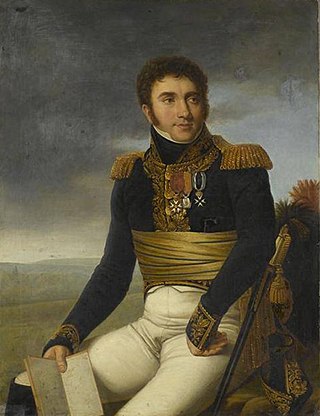
Jean-Marie Defrance was a French General of the French Revolutionary Wars and the Napoleonic Wars. He was also a member of the Council of Five Hundred, and a teacher at the military school of Rebais, Champagne.
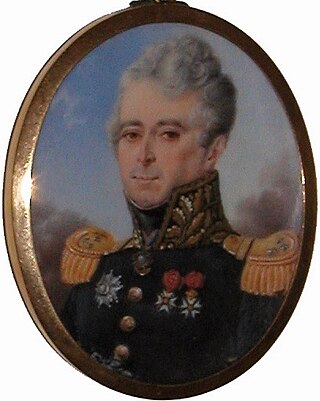
Anne-François-Charles Trelliard or Treillard or Treilhard, joined the cavalry of the French Royal Army as a cadet gentleman in 1780. During the French Revolutionary Wars he fought in Germany and Holland, eventually rising in rank to become a general officer in 1799. He led a corps cavalry brigade at Austerlitz in the 1805 campaign. In the 1806–1807 campaign he fought at Saalfeld, Jena, and Pultusk.

Antoine Maurin commanded a French cavalry division in 1814 during the Napoleonic Wars and in 1815 led his troops against the Prussians at Ligny where he was wounded. His army service began in 1792 during the French Revolution when he enlisted in a cavalry regiment as a trooper. He spent his entire military career as a cavalryman. During the French Revolutionary Wars he advanced through the ranks and became commander of a light cavalry regiment in 1802. While only a colonel, he commanded a brigade at Caldiero in October 1805. He fought in the Friedland campaign in 1807 and attained the rank of general officer that year. As a cavalry brigadier, he participated in the 1807 Invasion of Portugal but was captured in 1808 and held until 1812. He led a brigade in 1813 and a division in 1814 during the War of the Sixth Coalition. After fighting for Napoleon during the Hundred Days, he retired in 1823. His surname is one of the names inscribed under the Arc de Triomphe, on Column 40.

Nicolas Bernard Guiot de Lacour led infantry and cavalry brigades during the First French Empire under Napoleon. He joined the French Royal Army in 1787 and was sent to quell the Haitian Revolution in 1791. He fought in the Army of the North starting in 1793. He was promoted to chef de brigade (colonel) in 1797 and to general of brigade in 1800. He led a cavalry brigade at Caldiero in 1805 and initially commanded the Siege of Gaeta in 1806. He fought at Abensberg, Landshut, and Eckmühl in 1809 before being fatally wounded at the Battle of Wagram on 6 July 1809. Promoted general of division on the battlefield, he died of his wounds on the 28th. He is one of the names inscribed under the Arc de Triomphe on Column 11 and his bust is in the Hall of Battles at the Palace of Versailles.

Antoine Digonet commanded a French brigade during the French Revolutionary Wars and Napoleonic Wars. He joined the French Royal Army and fought in the American Revolutionary War as a foot soldier. In 1792 he was appointed officer of a volunteer battalion. He fought the Spanish in the War of the Pyrenees and was promoted to general officer. Later he was transferred to fight French royalists in the War in the Vendée. In 1800 he was assigned to the Army of the Rhine and led a brigade at Stockach, Messkirch and Biberach. Shortly after, he was transferred to Italy. In 1805 he fought under André Masséna at Caldiero. He participated in the 1806 Invasion of Naples and led his troops against the British at Maida where his brigade put up a sturdy resistance. After briefly serving in the 1809 war, he took command of Modena and died there of illness in 1811. He never married.
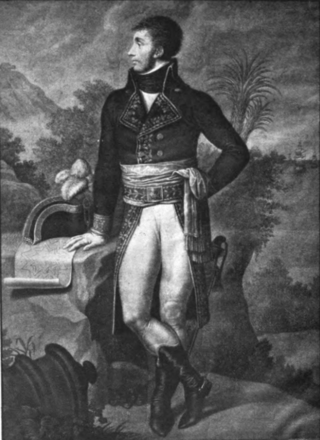
Jean Hardy commanded a French division during the French Revolutionary Wars. In 1783 he enlisted in the French Royal Army. In 1792 he joined a volunteer battalion and fought at Valmy, earning promotion to major. After leading a battalion at Wattignies and successfully holding Philippeville in 1793, he became a general of brigade. In 1794, he led troops in the Army of the Ardennes at Boussu-lez-Walcourt, Grandreng, Gosselies and Fleurus.
Paul-Alexis Dubois commanded French divisions during the War of the First Coalition and was killed in action fighting against Habsburg Austria. He enlisted in a French infantry regiment in 1770 and transferred into the cavalry in 1776. Thereafter he served in several different cavalry and infantry regiments. From sous-lieutenant in 1791, he served in the Army of the Moselle and was rapidly promoted to general of brigade by August 1793. After briefly commanding an infantry division in the Army of the Rhine at Wissembourg he switched back to the Army of the Moselle to fight at Kaiserslautern before being wounded at Froeschwiller in December 1793.

Éloi Laurent Despeaux commanded a combat infantry division during the French Revolution. He joined the French Royal Army in 1776 and became a non-commissioned officer by 1791 when he reentered civilian life. The following year he joined a volunteer battalion and fought at Jemappes. He was badly wounded at Famars in May 1793 and was appointed general of brigade in the Army of the North in September that year. After being wounded again he was promoted general of division in March 1794.
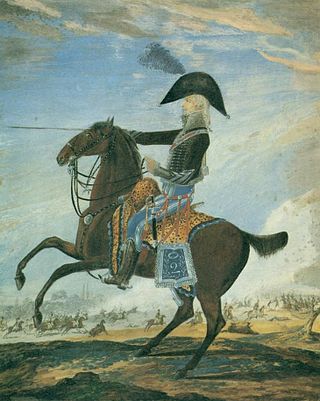
Charles Étienne de Ghigny commanded a Kingdom of the Netherlands light cavalry brigade at the Battle of Waterloo. He joined a French light cavalry regiment in 1792 and served in the same regiment for 22 years, becoming its lieutenant colonel in 1806. He fought in the Peninsular War in 1810–1811 and in the latter year became colonel of the regiment. He fought in the 1812 French invasion of Russia, the 1813 German Campaign and the 1814 French Campaign. In 1814 he led a cavalry regiment at Fère-Champenoise and Paris. He changed his allegiance to the Netherlands in 1815 and was appointed major general. He was promoted to lieutenant general in 1826. He switched allegiance to the Kingdom of Belgium in 1831 and received the Order of Leopold in 1837.

Charles Claude Jacquinot commanded a French cavalry division at the Battle of Waterloo in 1815. He joined a volunteer battalion in 1791 and transferred to a light cavalry regiment as a junior officer in 1793. He earned promotion to squadron commander and was acting commander of his regiment at Hohenlinden in 1800. After serving in a staff position at Austerlitz in 1805, he led a light cavalry regiment at Jena in 1806. Promoted to general of brigade he led his horsemen at Abensberg, Raab and Wagram in 1809. During the French invasion of Russia he fought at Ostrovno, Smolensk and Borodino in 1812. During the 1813 German Campaign he led a cavalry brigade at Dennewitz and Leipzig. After being appointed general of division he fought at Second Bar-sur-Aube and Saint-Dizier in 1814. During the Hundred Days he rallied to Napoleon and led a light cavalry division in the Waterloo campaign. After 15 years of inactivity, he was restored to favor in the 1830s. Thereafter he held a number of commands and was appointed to the Chamber of Peers. His surname is one of the names inscribed under the Arc de Triomphe, on Column 20.

Pierre Margaron led the French cavalry at the Battle of Vimeiro in 1808. He joined a volunteer battalion in 1792. He rose in rank during the French Revolutionary Wars until he commanded a heavy cavalry regiment in 1798. He led his horsemen at the Trebbia, Novi and Genola in 1799 and Pozzolo and San Massimo in 1800. He became a general of brigade in 1803 and led a corps light cavalry brigade at Austerlitz, Jena and Lübeck. He participated in the 1807 invasion of Portugal and fought at Évora and Vimeiro. From 1810 to 1812 he held a post in the interior. He became a general of division in 1813 and led troops at the Battle of Leipzig. His surname is one of the names inscribed under the Arc de Triomphe, on Column 2.

Christophe Antoine Merlin became a French division commander during the Napoleonic Wars. He joined a volunteer regiment in 1791 and fought against the Kingdom of Spain in the War of the Pyrenees. After becoming an officer in the 4th Hussar Regiment, he participated in the Rhine and Italian campaigns. In 1805 he was promoted general of brigade and fought in Italy and in the 1806 Invasion of Naples. Later he became an equerry to Joseph Bonaparte when that individual headed the Kingdom of Naples.

Pierre Barrois became a French division commander during the Napoleonic Wars. He joined a volunteer battalion in 1793 that later became part of a famous light infantry regiment. He fought at Wattignies, Fleurus, Aldenhoven, Ehrenbreitstein and Neuwied in 1793–1797. He fought at Marengo in 1800. He became colonel of a line infantry regiment in 1803 and led it at Haslach, Dürrenstein, Halle, Lübeck and Mohrungen in 1805–1807. Promoted to general of brigade, he led a brigade at Friedland in 1807.

André de La Barre was born in New France and joined France's colonial forces at a very young age. In 1764, he trained as an artillerist, but transferred to a cavalry unit as a volunteer three years later. In 1772 he officially joined the French Royal Army as a sous lieutenant of dragoons. In 1779, he was wounded at Savannah in the American Revolutionary War. By 1788, he was a staff officer with the rank of major. The start of the War of the First Coalition allowed officers chances for rapid advancement. Named a general of brigade in August 1793, La Barre fought at Toulon that year. Going to the Army of the Eastern Pyrenees, he distinguished himself at Boulou in May 1794. He was killed leading his cavalrymen in action at La Junquera on 7 June 1794.
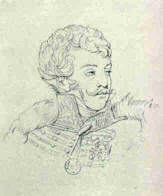
Jean Pierre Joseph Bruguière, called Bruyère, was a French military officer. He served in the French Revolutionary Wars and eventually became a general and prominent cavalry commander during the Napoleonic Wars. He was mortally wounded by a cannonball at the Battle of Reichenbach.


















